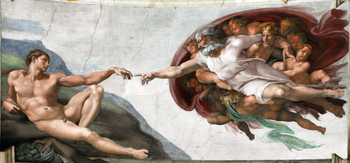High Renaissance: Difference between revisions
No edit summary Tag: Text added at end of page |
|||
| Line 46: | Line 46: | ||
[[pt:Alta Renascença]] |
[[pt:Alta Renascença]] |
||
[[sv:Högrenässans]] |
[[sv:Högrenässans]] |
||
testicles testicles andddd vigina |
|||
Revision as of 13:34, 12 April 2011

The expression High Renaissance, in art history, is a periodizing convention used to denote the apogee of the visual arts in the Italian Renaissance. The High Renaissance period is usually taken to begin in the 1490s, with Leonardo's fresco of the Last Supper in Milan and the death of Lorenzo de' Medici in Florence, and to have ended in 1527 with the sacking of Rome by the troops of Charles V.
Overview
The High Renaissance is generally taken to refer to a period of exceptional artistic production in the Italian states, principally Rome, capital of the Papal States, under Pope Julius II. Assertions about where and when the period begins and ends vary, but in general the best-known exponents of Italian Renaissance painting are painters of the High Renaissance, including Leonardo da Vinci, Michelangelo and early Raphael. Extending the general rubric of Renaissance culture, the visual arts of the High Renaissance were marked by a renewed emphasis upon the classical tradition, the expansion of networks of patronage, and a gradual attenuation of figural forms into the style later termed Mannerism.
The paintings in the Vatican by Michelangelo and Raphael represent the culmination of High Renaissance style in painting. The scale of these works, coupled with the complexity of their composition, closely-observed human figures, and pointed iconographic and decorative references to classical antiquity, can be viewed as emblematic of the High Renaissance.
Architecture

High Renaissance style in architecture conventionally begins with Donato Bramante, whose Tempietto at S. Pietro in Montorio at Rome was begun in 1510. The Tempietto, in both its design and concept, signifies a full-scale revival of ancient Roman commemorative architecture. David Watkin writes that the Tempietto, like Raphael's works in the Vatican (1509-11), "is an attempt at reconciling Christian and humanist ideals".[1]
Painting


The High Renaissance is widely viewed as a great explosion of creative genius, following a model of art history first proposed by the Florentine Giorgio Vasari. Even relatively minor painters of the period, such as Fra Bartolomeo and Mariotto Albertinelli, produced works that are still lauded for the harmony of their design and their technique. The elongated proportions and exaggerated poses in the late works of Michelangelo, Andrea del Sarto and Correggio prefigure so-called Mannerism, as the style of the later Renaissance is referred to in art history.
The serene mood and luminous colours of paintings by Giorgione and early Titian exemplify High Renaissance style as practiced in Venice. Other recognizable pieces of this period include Leonardo da Vinci's Mona Lisa and Raphael's The School of Athens. Raphael's fresco, set beneath an arch, is a virtuoso work of perspective, composition and disegno.
Sculpture

High Renaissance sculpture, as exemplified by Michelangelo's Pietà and the iconic David, is characterized by an "ideal" balance between stillness and movement. High Renaissance sculpture was normally commissioned by the public and the state, this becoming more popular for sculpture is an expensive art form. Sculpture was often used to decorate or embellish architecture, normally within courtyards where others were able to study and admire the commissioned art work. Wealthy individuals like cardinals, rulers and bankers were the more likely private patrons along with very wealthy families; Pope Julius II also patronized many artists. During the High Renaissance there was the development of small scale statuettes for private patrons, the creation of busts and tombs also developing. The subject matter related to sculpture was mostly religious but also with a significant strand of classical individuals in the form of tomb sculpture and paintings as well as ceilings of cathedrals.
Other period developments
During the High Renaissance period, Christopher Columbus traveled to what later become known as America (though he was, in fact, searching for a faster trade route to India) and Nicholas Copernicus discovered that Earth exists in a heliocentric solar system, contrary to the geocentric belief of centuries prior that held that the Earth is central and stationary, with all heavenly bodies orbiting it.[2]
References
testicles testicles andddd vigina
